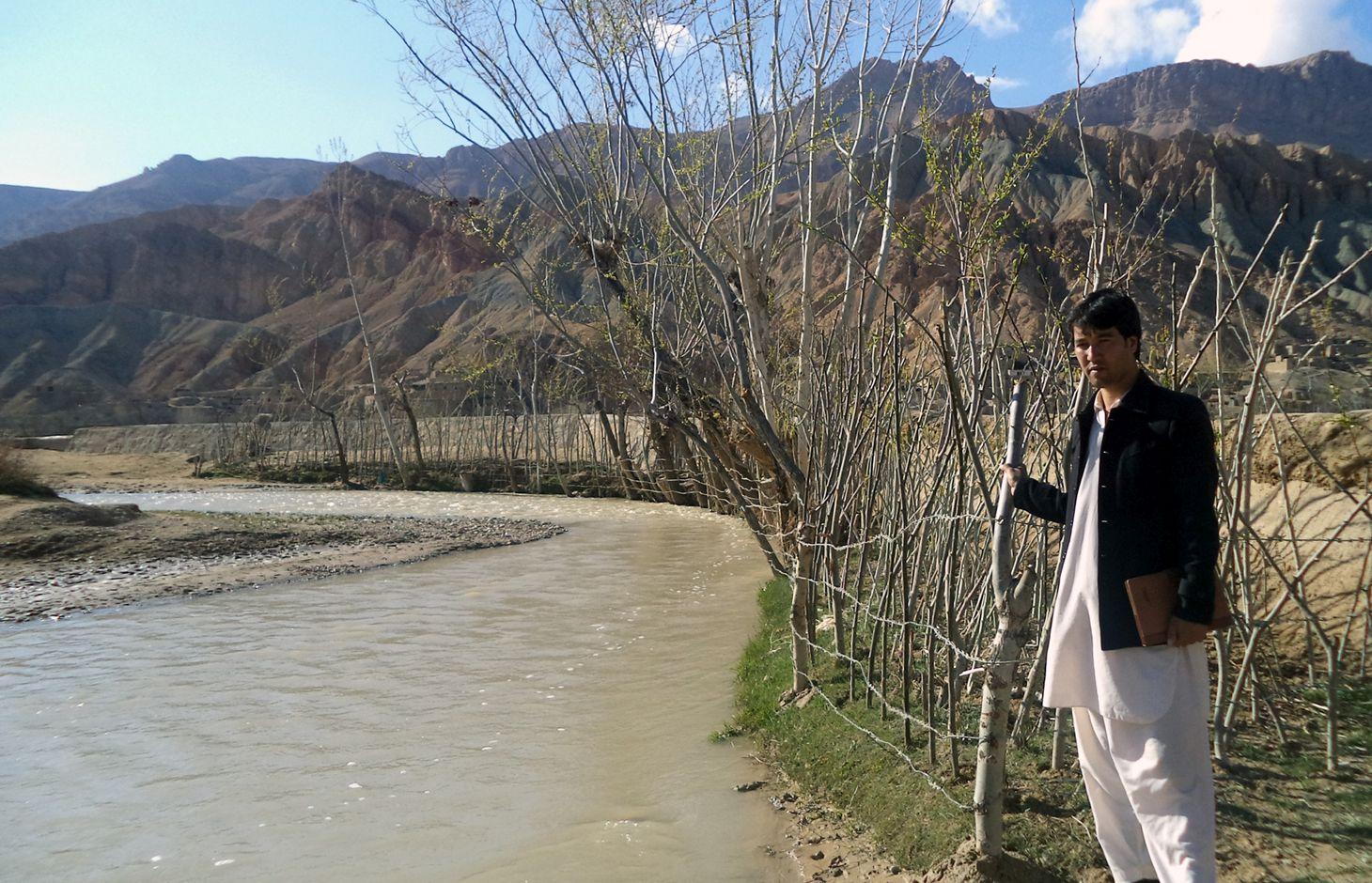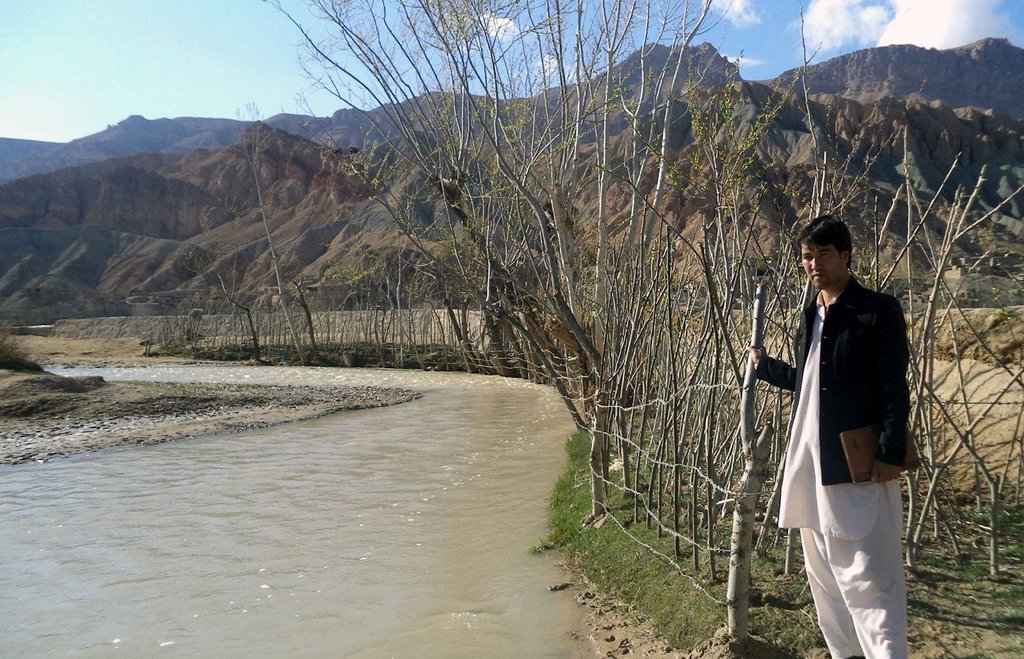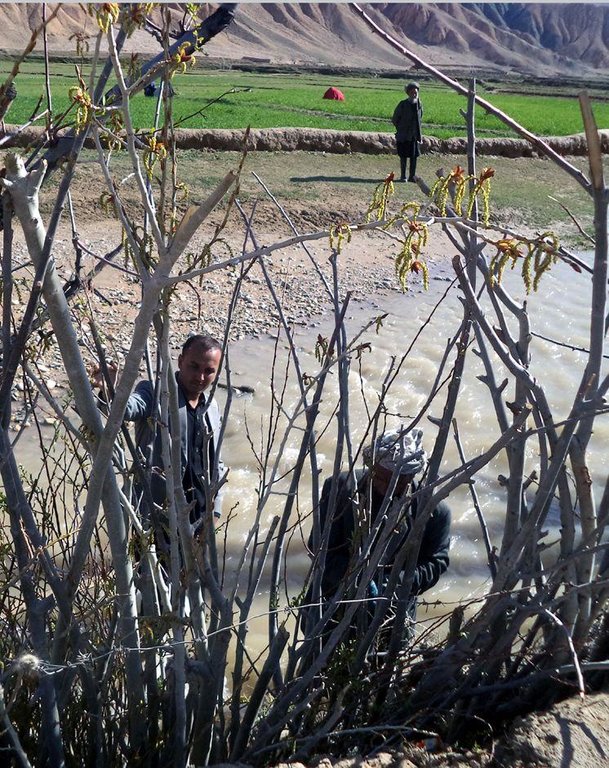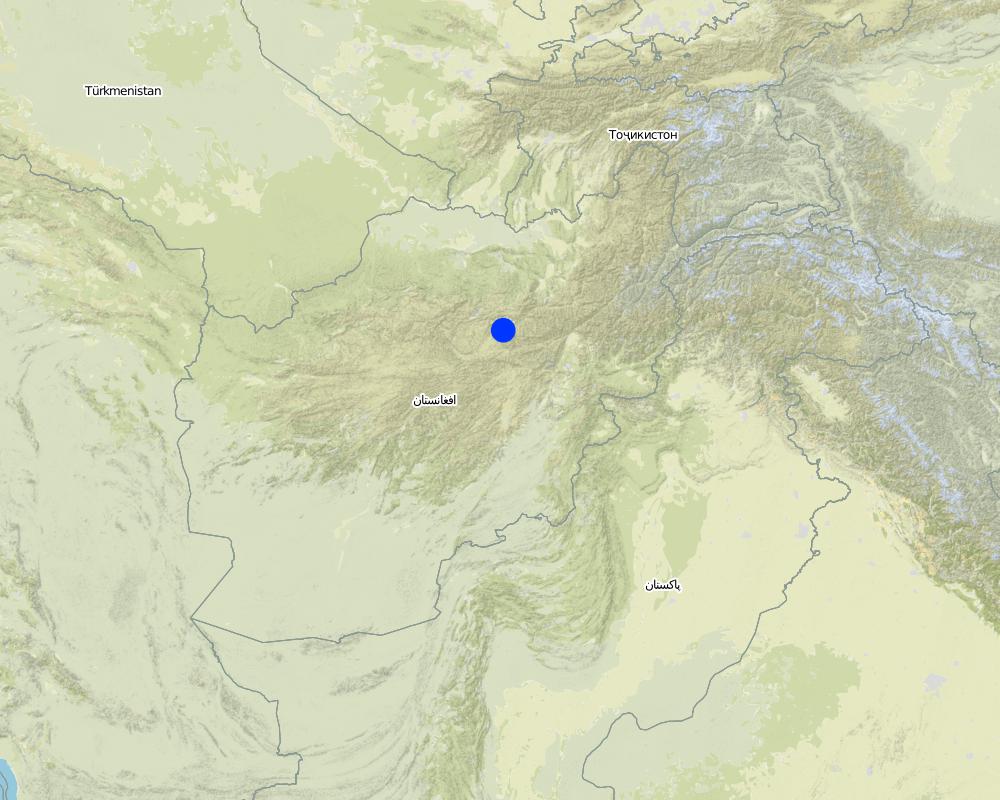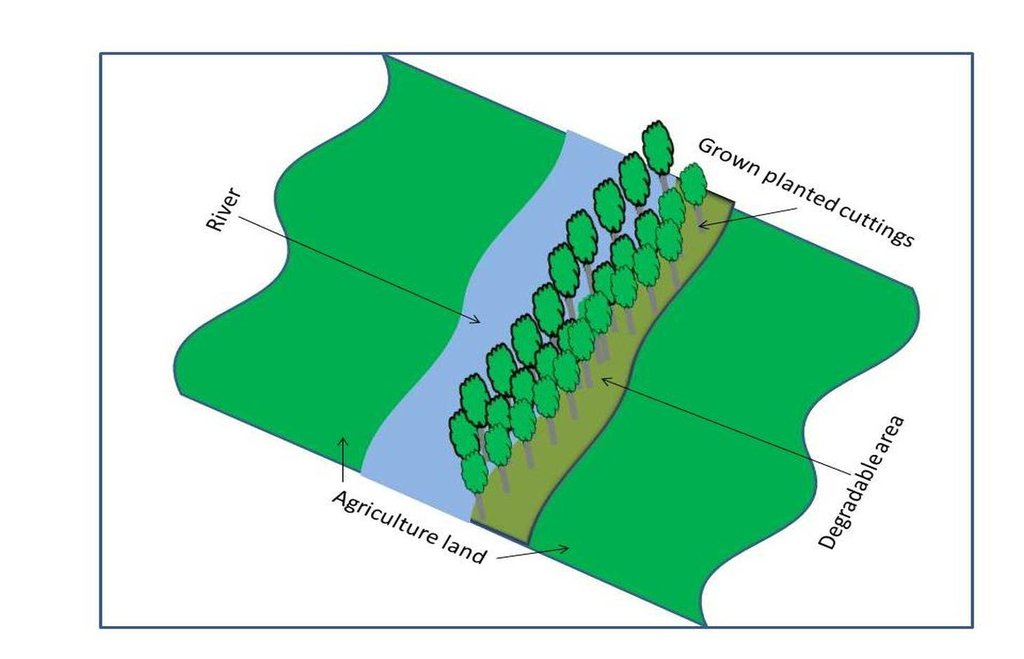Riverbank stabilization [أفغانستان]
- تاريخ الإنشاء:
- تحديث:
- جامع المعلومات: Aqila Haidery
- المحرر: –
- المراجعون: Deborah Niggli, Joana Eichenberger
Nehal Shani Kenar Darya
technologies_1285 - أفغانستان
عرض الأقسام
توسيع الكل طي الكل1. معلومات عامة
1.2 تفاصيل الاتصال بالأشخاص الرئيسيين لمصدر المعلومات والمؤسسات المشاركة في تقييم وتوثيق التقنية
متخصص في الإدارة المستدامة للأراضي:
متخصص في الإدارة المستدامة للأراضي:
Slaimankhil Abdul Ghafar
HELVETAS Swiss Intercooperation, Afghanistan
أفغانستان
اسم المؤسسة (المؤسسات) التي سهلت توثيق/تقييم التقنية (إذا كان ذلك على صلة)
HELVETAS (Swiss Intercooperation)1.3 الشروط المتعلقة باستخدام البيانات الموثقة من خلال WOCAT
يوافق جامع المعلومات والشخص (لاشخاص) الرئيسي لمصدر المعلومات على الشروط المتعلقة باستخدام البيانات الموثقة من خلال WOCAT:
نعم
1.4 إعلان بشأن استدامة التقنية الموصوفة
هل التقنية الموصوفة هنا تمثل مشكلة فيما يتعلق بتدهور الأراضي، بحيث لا يمكن إعلانها تقنية مستدامة لإدارة الأراضي؟:
كلا
2. وصف تقنيةالإدارة المستدامي للأراضي
2.1 وصف مختصر للتقنية
تعريف التقنية:
A low cost and an easy activity for protecting agricultural lands, gardens and public infrastructure from the damages of flash flood.
2.2 وصف تفصيلي للتقنية
الوصف:
Lack of vegetation coverage in the hills and mountains of Saighan district has become the source of destructive flash floods. Harvest of shrubs and other vegetation for fuel wood and the uncontrolled grazing of animals in upper catchment areas are some of the reasons for the loss of vegetation. Flash floods, that mainly occur during the spring and summer seasons, destroy many hectares of agriculture lands and gardens,damage public infrastructures and sometimes threatens lives.
The plantation of long root trees in lower catchment areas is an effective and low-cost technology. Its objective is to prevent flood damage. Trees
hold the soil in place with their root structures decreasing land degradation and soil erosion. It is a low cost activity that can be
alternative option to protection walls which are more costly, both in terms of establishments and maintenance. Additional benefits of the technology are the increased availability of wood beams for
construction, of fuel wood and of fodder. This technology, coupled with information campaigns, may help to provide a strong disincentive against
cutting shrubs and grazing in upper catchment areas. In addition, increasing the number of indigenous trees help reduce the negative effects of climate change. The trees also serve as wind breaks.
Having mobilized the community, areas along the watercourse that have been damaged by floods as well as unproductive lands were selected. Based on their ability to adapt well to the local environment, cuttings of Salix (or Willow) and Populus (or Poplar) were selected for planting. Cuttings were provided from the district. Each participating household planted 400 cuttings (2 m long size). The cuttings were planted at a distance of 25 cm and the line to line distance was 100 cm. For the first year, wooden belts, placed along the plating line may protect the new saplings from flood damages, ensuring that the sapling are able to grow. Protection by fencing with barbed wire in two first years also prevents grazing of leaves and new branches by animals.
Interested households should be introduced by the Community Development Council members through a transparent selection process and considering the following criteria:
•the household should be interested to plant long root tree cuttings;
•the household should have enough degraded / riverbank and waste land to plant cuttings;
•Willingness to invest.
The cost of applying riverbank stabilization (plantation of Salix and Populus) is estimated to be 10 AFN/cutting. One person can plant over 500 cuttings per day. In this case, 50% of the cutting cost was contributed by HELVETAS projects and 50% of the cost of the cuttings was contributed by the participating households.
Participating households maintain the plantations. They are responsible for irrigating the cuttings and for protecting them from grazing animals for the first few years. In addition to improved flood protection, participating households increased their understanding riverbank stabilization and energy plantation and managing cuttings (selection, land preparation, fascine and palisade plantation).
Bamyan province is a remote province of Afghanistan with a high poverty rate. It has a semi-arid climate with cold winters and hot and dry summers. During winter, temperatures can drop below -22 degrees. Summer temperatures can reach 34 degrees in the month of July. The average annual rainfall in the area is about 230 mm and some years can be very dry. 90% of the population relies on subsistence agriculture for their livelihoods and off-farm activities are marginal. The growing season in Saighan district is relatively short from April to October and farmers can produce only one crop per year. Farmers with access to irrigation water cultivate cash crops, for example potato and vegetables, in addition to staple crops (wheat) and fodder crops. Those without access to irrigation water cultivate wheat and fodder crops only. Water scarcity during May to September may result to lack of high value crops.
2.3 صور التقنية
2.5 البلد/المنطقة/المواقع التي تم تنفيذ التقنية فيها والتي يغطيها هذا التقييم
البلد:
أفغانستان
المنطقة/الولاية/المحافظة:
Bamyan
مزيد من التفاصيل حول الموقع:
Saighan
حدد انتشار التقنية:
- منتشرة بالتساوي على مساحة
إذا كانت التقنيةا موزعة بالتساوي على منطقة ما، حدد المساحة المغطاة (بالكيلومتر المربع):
0,0000985
التعليقات:
Total area covered by the SLM Technology is 98.5 m2.
Map
×2.6 تاريخ التنفيذ
في حالة عدم معرفة السنة بالتحديد، يرجى الإشارة إلى التاريخ التقريبي:
- منذ أقل من 10 سنوات (مؤخرًا)
2.7 إدخال التقنية
حدد كيف تم إدخال التقنية:
- من خلال المشاريع/ التدخلات الخارجية
التعليقات (نوع المشروع، الخ):
When the people migrated in other provinces, they saw over there and learnt. Since 2011 HELVETAS introduced this activity for alternative option of cutting shrubs and low cost protection wall against flood damages.
3. تصنيف تقنية الإدارة المستدامي للأراضي
3.1 الغرض الرئيسي ( الأغراض الرئيسية) للتقنية
- الحد من تدهور الأراضي ومنعه وعكسه
- الحد من مخاطر الكوارث
3.2 نوع (أنواع) استخدام الأراضي الحالية حيث يتم تطبيق التقنية

أراضي الرعي
الرعي الواسع النطاق:
- رعي شبه مرتحل
الرعي المكثف/ إنتاج الأعلاف:
- قطع وحمل / صفر مرعى

المجاري المائية، المسطحات المائية، الأراضي الرطبة
- البرك والسدود
التعليقات:
Major land use problems (compiler’s opinion): Lack of sustainable land management, uncontrolled overgrazing of animals and collection of woods and bushes for fuel by the people in the upper catchment area. Occurrence of flash floods which damage public infrastructure, gardens and farm lands the sources of livelihoods downstream areas.
Major land use problems (land users’ perception): Population increase and lack of resources and service delivery during the war caused over exploitation of resources in upper catchment areas. Increase in flock sizes to improve incomes which resulted to overgrazing.
Semi-nomadism / pastoralism: People move their flocks to other provinces and graze also in the area hill and mountaines
Cut-and-carry/ zero grazing: Provide fodder from agriculture land and graze in unimproved pasture areas. People have less animals like sheep, goat and cows
Number of growing seasons per year: 1
Longest growing period in days: 90, Longest growing period from month to month: April to June; Second longest growing period in days: 120, Second longest growing period from month to month: July to October
Livestock density: 1-10 LU /km2
3.3 هل تغير استخدام الأراضي نتيجة لتنفيذ التقنية؟
هل تغير استخدام الأراضي نتيجة لتنفيذ التقنية؟:
- نعم (يرجى ملء الأسئلة أدناه فيما يتعلق باستخدام الأراضي قبل تنفيذ التقنية)

المجاري المائية، المسطحات المائية، الأراضي الرطبة
- خطوط الصرف، الممرات المائية
- البرك والسدود
3.4 إمدادات المياه
إمدادات المياه للأرض التي يتم تنفيذ التقنية عليها:
- ري كامل
3.5 مجموعةالإدارة المستدامة للأراضي التي تنتمي إليها هذه التقنية
- إدارة المياه السطحية (الينابيع، الأنهار، البحيرات، البحار)
- حماية/ إدارة الأراضي الرطبة
3.6 التدابير التقنية في مجال إلادارة المستدامة للأراضي

التدابير النباتية
- V1: غطاء من الأشجار والشجيرات
التعليقات:
Type of vegetative measures: aligned: -along boundary
3.7 الأنواع الرئيسية من تدهور الأراضي التي تناولتها التقنية

تآكل التربة بالمياه
- الوزن(Wt): فقدان التربة السطحية/تآكل السطح
- (Wr):انجراف ضفة النهر

تآكل التربة الناتج عن الرياح
- (Et): فقدان التربة السطحية
التعليقات:
Main causes of degradation: deforestation / removal of natural vegetation (incl. forest fires) (Cutting shrubs of upper catchments increased naked area, so flash flood and drought years resulted), overgrazing (Free grazing of animals in spring and summer seasons resulted that domestic plants have eaten by animals before producing seed), floods (Naked area of upper catchments is the source of comming multi times flood per year), population pressure (Increasing population demanded more), war and conflicts (War limited services and caused less availability of fuel)
Secondary causes of degradation: droughts (No vegetation coverage increased temprature of the area and reduced deep moisture of soil), poverty / wealth (Poverty is the reason of destroying natural resources), governance / institutional (Lack of good governance for having development strategy)
3.8 منع أو حد أو عكس تدهور الأراضي
تحديد هدف التقنية فيما يتعلق بتدهور الأراضي:
- منع تدهور الأراضي
- الحد من تدهور الأراضي
4. المواصفات الفنية، وأنشطة التنفيذ، والمدخلات، والتكاليف
4.1 الرسم الفني للتقنية
المواصفات الفنية (المتعلقة بالرسم الفني):
The technology should be applied along the damageable areas into multi lines. The technoIogy should be applied along the
damaged areas in multiple lines.
Location: Saighan district. Bamyan province
Date: 12/10/2015
Technical knowledge required for field staff / advisors: high (To advice and train people on lining system and propaganda of its importance)
Technical knowledge required for land users: moderate
Main technical functions: stabilisation of soil (eg by tree roots against land slides), reduction in wind speed
Secondary technical functions: control of raindrop splash, improvement of surface structure (crusting, sealing), improvement of topsoil structure (compaction), improvement of subsoil structure (hardpan)
Aligned: -along boundary
Vegetative material: T : trees / shrubs
Number of plants per (ha): 5000
Vertical interval between rows / strips / blocks (m): 2
Spacing between rows / strips / blocks (m): 1
Vertical interval within rows / strips / blocks (m): 2
Width within rows / strips / blocks (m): 0.25
Trees/ shrubs species: Salix, poplar
Slope (which determines the spacing indicated above): >50%
If the original slope has changed as a result of the Technology, the slope today is (see figure below): 15-30%
Gradient along the rows / strips: >3%
المؤلف:
Shabir Shahem, HELVETAS Swiss Intercooperation, Afghanistan
4.2 معلومات عامة بخصوص حساب المدخلات والتكاليف
عملة أخرى/ عملة وطنية (حدد):
Afghani
إذا كان ذا صلة، وضح سعر الصرف من الدولار الأمريكي إلى العملة المحلية (على سبيل المثال، 1 دولار أمريكي = 79.9 ريال برازيلي): 1 دولار أمريكي =:
64,0
اذكر متوسط تكلفة أجر العمالة المستأجرة في اليوم الواحد:
5.46
4.3 أنشطة التأسيس
| النشاط | التوقيت (الموسم) | |
|---|---|---|
| 1. | Cutting preparation and plantation | 5 days (April) |
4.4 التكاليف والمدخلات اللازمة للتأسيس
| تحديد المدخلات | الوحدة | الكمية | التكاليف لكل وحدة | إجمالي التكاليف لكل مدخل | % من التكاليف التي يتحملها مستخدمو الأراضي | |
|---|---|---|---|---|---|---|
| العمالة | labour | ha | 1,0 | 54,6 | 54,6 | 100,0 |
| غير ذلك | cutting | ha | 1,0 | 1562,5 | 1562,5 | 50,0 |
| إجمالي تكاليف إنشاء التقنية | 1617,1 | |||||
| إجمالي تكاليف إنشاء التقنية بالدولار الأمريكي | 25,27 | |||||
التعليقات:
Duration of establishment phase: 0.33 month(s)
4.5 الصيانة/الأنشطة المتكررة
| النشاط | التوقيت/الوتيرة | |
|---|---|---|
| 1. | No maintenance cost is required so far. |
4.6 التكاليف والمدخلات اللازمة للصيانة/للأنشطة المتكررة (سنويًا)
التعليقات:
Riverbank establishment cost is calculated here assuming that the soil is soft, gulleys have not formed and the cuttings are available within the villages and cost efficiently provided by the farmer.
4.7 أهم العوامل المؤثرة على التكاليف
قدم وصفا لأهم العوامل التي تؤثر على التكاليف:
The severity of erosion, hard soil and lack of long root cuttings are the factors which effect the cost of riverbank establishment the most.
5. البيئة الطبيعية والبشرية
5.1 المناخ
هطول الأمطار السنوي
- < 250 مم
- 251- 500 ملم
- 501 - 750ملم
- 1,000-751 ملم
- 1,500-1,100 ملم
- 2,000-1,500 ملم
- 3,000-2,001 ملم
- 4,000-3,100 ملم
- > 4000 ملم
المواصفات/التعليقات على هطول الأمطار:
Annual rainy days are 37 and snowy days are 14 days, mostly June to September are dry months.
المنطقة المناخية الزراعية
- شبه قاحلة
Thermal climate class: temperate
5.2 طوبوغرافيا
متوسط الانحدارات:
- مسطح (0-2%)
- بسيط (3-5%)
- معتدل (6-10%)
- متدحرج (11-15%)
- تلال (16-30%)
- شديدة الانحدار(31-60%)
- فائقة الانحدار (>60%)
التضاريس:
- هضاب/سهول
- أثلام مرتفعة
- المنحدرات الجبلية
- منحدرات التلال
- منحدرات في السفوح
- قاع الوادي
المنطقة الارتفاعية:
- 100-0 متر فوق سطح البحر
- 500-101 متر فوق سطح البحر
- 1,000-501 متر فوق سطح البحر
- 1,500-1,001 متر فوق سطح البحر
- 2,000-1,501 متر فوق سطح البحر
- 2,500-2,100 متر فوق سطح البحر
- 3,000-2,501 متر فوق سطح البحر
- 4,000-3,001 متر فوق سطح البحر
- > 4000 متر فوق سطح البحر
5.3 التربة
متوسط عمق التربة:
- ضحل جدًا (0-20 سم)
- ضحلة (21-50 سم)
- متوسطة العمق (51-80 سم)
- عميقة (81-120 سم)
- عميقة جدًا (> 120 سم)
قوام التربة (التربة السطحية):
- متوسط ( طميي، سلتي)
المواد العضوية في التربة السطحية:
- متوسطة (1-3%)
5.4 توافر المياه ونوعيتها
منسوب المياه الجوفية:
50-5 م
توافر المياه السطحية:
متوسط
نوعية المياه (غير المعالجة):
مياه الشرب سيئة (تتطلب معالجة)
5.5 التنوع البيولوجي
تنوع الأنواع:
- متوسط
5.6 خصائص مستخدمي الأراضي الذين يطبقون التقنية
التوجه السوقي لنظام الإنتاج:
- مختلط (كفاف/ تجاري)
الدخل من خارج المزرعة:
- أقل من % 10من كامل الدخل
المستوى النسبي للثروة:
- ثري
- ثري جدا
أفراداً أو مجموعات:
- المجموعات/ المجتمع المحلي
مستوى المكننة:
- عمل يدوي
الجنس:
- رجال
اذكر الخصائص الأخرى ذات الصلة لمستخدمي الأراضي:
Land users applying the Technology are mainly common / average land users
Difference in the involvement of women and men: In Afghanistan societies women don't work in such hard works, although now women work out of their homes but they work as teacher, staff of organizations, self professionals and etc.
Population density: 10-50 persons/km2
Annual population growth: 3% - 4%; 3%
60% of the land users are very rich and own 30% of the land (Able to purchase cutting and hire worker).
30% of the land users are rich and own 40% of the land (Able to purchase cutting and hire worker).
10% of the land users are average wealthy and own 30% of the land (Able to purchase cutting and work by themselves). (Mainly they do not have land).
Off-farm income specification: Those people who not applied such technology, their lands are under threat of flood and to provide fuel wood should pay more in a year
5.7 متوسط مساحة الأرض التي يستخدمها مستخدمو الأراضي الذين يطبقون التقنية
- < 0.5 هكتارا
- 0.5 - 1 هكتار
- 1 -2 هكتار
- 2 - 5 هكتار
- 5 - 15 هكتار
- 15 - 50 هكتار
- 50 - 100هكتار
- 500-100 هكتار
- 1,000-500 هكتار
- 10,000-1,000 هكتار
- > 10,000 هكتار
هل يعتبر هذا نطاقًا صغيرًا أو متوسطًا أو واسعا (في إشارة إلى السياق المحلي)؟:
- على نطاق متوسط
5.8 ملكية الأراضي، وحقوق استخدام الأراضي، وحقوق استخدام المياه
ملكية الارض:
- فردية، لا يوجد سند ملكية
حقوق استخدام الأراضي:
- فردي
- individual/communal
- individual/communal
التعليقات:
The water use rights is determined by hours on 2000m2 land area.
5.9 الوصول إلى الخدمات والبنية التحتية
الصحة:
- ضعيف
- معتدل
- جيد
التعليم:
- ضعيف
- معتدل
- جيد
المساعدة التقنية:
- ضعيف
- معتدل
- جيد
العمل (على سبيل المثال خارج المزرعة):
- ضعيف
- معتدل
- جيد
الأسواق:
- ضعيف
- معتدل
- جيد
الطاقة:
- ضعيف
- معتدل
- جيد
الطرق والنقل:
- ضعيف
- معتدل
- جيد
مياه الشرب وخدمات الصرف الصحي:
- ضعيف
- معتدل
- جيد
الخدمات المالية:
- ضعيف
- معتدل
- جيد
6. الآثار والتصريحات الختامية
6.1 الآثار التي أظهرتها التقنية في الموقع
الآثار الاجتماعية والاقتصادية
الإنتاج
إنتاج الأعلاف
الكمية قبل الإدارة المستدامة للأراضي:
0
الكمية بعد الإدارة المستدامة للأراضي:
19700 kg
التعليقات/ حدد:
The leaves of tree can be more after 5 years, now the saplings are small size
إنتاج الخشب
الكمية قبل الإدارة المستدامة للأراضي:
0
الكمية بعد الإدارة المستدامة للأراضي:
985 pcs
التعليقات/ حدد:
It is going to be increased after some years when the tree saplings groth more sizes
منطقة الإنتاج
الكمية قبل الإدارة المستدامة للأراضي:
0
الكمية بعد الإدارة المستدامة للأراضي:
49250 kg
التعليقات/ حدد:
Fuel wood increased
توليد الطاقة
الكمية قبل الإدارة المستدامة للأراضي:
0
الكمية بعد الإدارة المستدامة للأراضي:
50
التعليقات/ حدد:
The household who applied technology are about sufficient from fuel energy
الآثار الاجتماعية والثقافية
الأمن الغذائي / الاكتفاء الذاتي
الكمية قبل الإدارة المستدامة للأراضي:
0
الكمية بعد الإدارة المستدامة للأراضي:
20%
التعليقات/ حدد:
Houshoulds who applied the technology now they don't pay for providing fuel wood as more as they paid in the past. they provide fuel wood more from their established forest and save their moneys for other needs
المعرفة بالإدارة المستدامة للأراضي/تدهور الأراضي
التعليقات/ حدد:
People undrestood it is a good technique to control soil erosion and get fuel wood to do not go got mountains for cutting shrubs
التخفيف من حدة الصراع
الكمية قبل الإدارة المستدامة للأراضي:
0
الكمية بعد الإدارة المستدامة للأراضي:
30%
contribution to human well-being
التعليقات/ حدد:
Now the boys don't go to the mountains to collect bushes for fuel wood and get education. It has as well contributed the households economically as they do not need to spend money in purchasing fuel wood.
الآثار الايكولوجية
التربة
غطاء التربة
الكمية قبل الإدارة المستدامة للأراضي:
0
الكمية بعد الإدارة المستدامة للأراضي:
30%
التعليقات/ حدد:
Now the hard wind is not a reason of soil erosion in covered land areas and it get more however the trees grow more and become tall
فقدان التربة
الكمية قبل الإدارة المستدامة للأراضي:
0
الكمية بعد الإدارة المستدامة للأراضي:
50%
التعليقات/ حدد:
Protection of area from damage of flood and wind by tree belts decreased soil loss of agriculture lands
المادة العضوية في التربة/تحت الطبقة c
الكمية قبل الإدارة المستدامة للأراضي:
10
الكمية بعد الإدارة المستدامة للأراضي:
50%
التعليقات/ حدد:
Raw materials which accelerate micro organism activities increase in the area
التنوع البيولوجي: الغطاء النباتي، الحيوانات
الكتلة الحيوية/ طبقة الكربون فوق التربة
الكمية قبل الإدارة المستدامة للأراضي:
10%
الكمية بعد الإدارة المستدامة للأراضي:
50%
التعليقات/ حدد:
Fallen leaves increased biomass
الحد من مخاطر المناخ والكوارث
سرعة الرياح
الكمية قبل الإدارة المستدامة للأراضي:
0
الكمية بعد الإدارة المستدامة للأراضي:
30%
التعليقات/ حدد:
Wind breaks and protected about more than 3 Hectare agriculture lands
6.2 الآثار التي أظهرتها التقنية خارج الموقع
الفيضان في اتجاه مجرى النهر
الكمية قبل الإدارة المستدامة للأراضي:
0
الكمية بعد الإدارة المستدامة للأراضي:
15%
التعليقات/ حدد:
Breaks wave of flood
الرواسب المنقولة بواسطة الرياح
الكمية قبل الإدارة المستدامة للأراضي:
0
الكمية بعد الإدارة المستدامة للأراضي:
50%
التعليقات/ حدد:
Decreased damages of wind and frost
الضرر على البنية التحتية العامة/ الخاصة
الكمية قبل الإدارة المستدامة للأراضي:
0
الكمية بعد الإدارة المستدامة للأراضي:
50%
التعليقات/ حدد:
Protected the road
6.3 تعرض التقنية وحساسيتها لتغير المناخ التدريجي والظواهر المتطرفة/الكوارث المرتبطة بالمناخ (كما يراها مستخدمو الأراضي)
تغير مناخ تدريجي
تغير مناخ تدريجي
| الموسم | زيادة أو نقصان | كيف تتعامل التقنية مع ذلك؟ | |
|---|---|---|---|
| درجة الحرارة السنوية | زيادة | جيدا |
الظواهر المتطرفة / الكوارث المرتبطة بالمناخ
الكوارث الجوية
| كيف تتعامل التقنية مع ذلك؟ | |
|---|---|
| عاصفة ممطرة محلية | جيدا |
| عاصفة هوائية محلية | جيدا |
الكوارث المناخية
| كيف تتعامل التقنية مع ذلك؟ | |
|---|---|
| جفاف | ليس جيدا |
الكوارث الهيدرولوجية
| كيف تتعامل التقنية مع ذلك؟ | |
|---|---|
| فيضان عام (نهر) | ليس جيدا |
العواقب الأخرى المتعلقة بالمناخ
العواقب الأخرى المتعلقة بالمناخ
| كيف تتعامل التقنية مع ذلك؟ | |
|---|---|
| انخفاض فترة النمو | ليس جيدا |
التعليقات:
During the first years, as the roots are still undeveloped, saplings should be protected by a stone wall from floods. During drought years saplings
should be irrigated at least 2 times per week over two years.
6.4 تحليل التكلفة والعائد
كيف يمكن مقارنة العوائد نسبة لتكاليف الإنشاء (من وجهة نظر مستخدمي الأراضي)؟
عوائد قصيرة الأجل:
إيجابي قليلا
عوائد طويلة الأجل:
ايجابي جدا
كيف تتم مقارنة العوائدمع كلفة الصيانة/التكاليف المتكررة (من وجهة نظر مستخدمي الأراضي)؟
عوائد قصيرة الأجل:
ايجابي جدا
عوائد طويلة الأجل:
ايجابي جدا
التعليقات:
Expenditure occurs mostly during the establishment of the technology. After a few years, benefits (including production) increase without significant expenditure.
6.5 اعتماد التقنية
- > 50%
من بين جميع الذين تبنوا التقنية، كم عدد الذين فعلوا ذلك بشكل تلقائي، أي دون تلقي أي حوافز مادية/مدفوعات؟:
- 91-100%
التعليقات:
It was applied as extension activity but when the others families learnt and saw the good results, they applied by themselves without any external supports
985 land user families have adopted the Technology without any external material support
The land users also decided to extend this activity in other place lands which they have.
There is a strong trend towards spontaneous adoption of the Technology
As this technology is applicable by each family and has good results, many other people has trend toward the spontaneous adoption of the technology.
6.7 نقاط القوة / المزايا / الفرص التي توفرها التقنية
| نقاط القوة/ المزايا/ الفرص من وجهة نظر مستخدمي الأراضي |
|---|
| Increasing fuel wood |
| Prevents occurrence of flash floods in the agricultural lands |
| نقاط القوة/ المزايا/ الفرص من وجهة نظر جامع المعلومات أو غيره من الاشخاص الرئيسيين لمصدر المعلومات |
|---|
| Applicable by rural community members. |
| Low cost technology to prevent damage of floods in comparison with concrete protection wall. |
| A good option for reducing shrubs cutting in the upper catchment areas. |
| Prevent soil erosion by winds |
| Contributes in the greening of the environment |
6.8 نقاط ضعف / مساوىء / مخاطر التقنية وسبل التغلب عليها
| نقاط الضعف/ المساوىء/ المخاطر من وجهة نظر جامع المعلومات أو غيره من الاشخاص الرئيسيين لمصدر المعلومات | كيف يمكن التغلب عليها؟ |
|---|---|
| Lack of good and improved cuttings | Production of good species in wood lot or nurseries |
| Small landholdings per households (limiting the establishment of the technology) | Group decision and motivating and involving larger group of people to apply the technology |
| Saplings are vulnerable towards floods in the first two years because still they have not long roots and saplings are as well small | Protection by a stone wall belt in the way of coming flood for 2 first years |
7. المراجع والروابط
7.1 طرق جمع/مصادر المعلومات
- زيارات ميدانية، مسوحات ميدانية
- مقابلات مع مستخدمي الأراضي
متى تم تجميع البيانات (ميدانيا)؟:
12/10/2015
7.2 المراجع للمنشورات المتاحة
العنوان، المؤلف، السنة، النظام القياسي الدولي لترقيم الكتب ISBN:
HELVETAS Swiss IntercooperationSaighan field officeILRC and GS projects 2012 to 2015
متاح من أين؟كم التكلفة؟:
HELVETAS Swiss Intercooperation, Afghanistan
الروابط والوحدات المواضيعية
توسيع الكل طي الكلالروابط
لا يوجد روابط
الوحدات المواضيعية
لا يوجد وحدات مواضيعية


